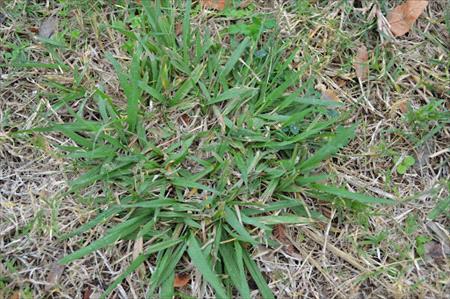Your Cart

Learn Your Lawn: Dallisgrass
Request a Quote
Dallisgrass is a warm-season grassy weed species found on residential lawns throughout the southern United States. It is a coarse-textured perennial that grows in an ever-enlarging circular clump. It sometimes grows so large that the center dies out while the outer rings continue to smother all other turf grasses in its path. Dallisgrass is very aggressive and can easily outcompete desirable grasses, making it difficult to control. Its short rhizomes root easily in moist soil, and it has a distinctive seed head that is tall and purplish in color and produces a large quantity of seeds. Dallisgrass will also thrive in sandy or clay soils, growing twice as fast as regular turf grasses and creating unsightly tufts for the homeowner. An effective way to control small infestations of Dallisgrass is to pull up individual plants by hand and then repair these areas with desirable grass seed varieties or sod. If the infestation is larger, other forms of control may be necessary. A thick, healthy, well-maintained lawn is always the best line of defense. This can be achieved through beneficial cultural practices, which include: Core Aeration: Aerating your lawn can improve soil drainage and help reduce the likelihood of lawn diseases. This will also alleviate soil compaction and allow water and nutrients to penetrate deeper into the soil. Fertilize Regularly: Regular applications of Weed Man’s specially formulated, slow-release granular fertilizer will help provide your lawn with adequate nutrients. These applications are timed specifically to avoid over fertilizing the lawn. Watering: Under normal circumstances, you should be watering your lawn a few times per week for 30-45 minutes in each area. During hot and dry periods, most lawns should be watered as much as required to maintain its desired green color. Always water in the early morning so the turf has time to dry by nightfall. Mowing: Maintain a regular mowing schedule with a razor sharp blade. Never remove more than a ⅓ of the grass blade at each mowing. Recommended Mowing Height Common Bermudagrass - ¾ to 1¼ inches Hybrid Bermudagrass - ½ to 1½ inches Centipedegrass - 1 to 2 inches Zoysiagrass - 1 to 2½ inches St. Augustine - 3 to 4 inches Fescue - 3 to 4 inches Your local Weed Man professional will be able to offer other solutions and recommend the best form of treatment that is suitable to improve the conditions of your lawn.What Is Dallisgrass?
How Can I Control Dallisgrass In My Lawn?
 English (USA)
English (USA) Français (CANADA)
Français (CANADA)

